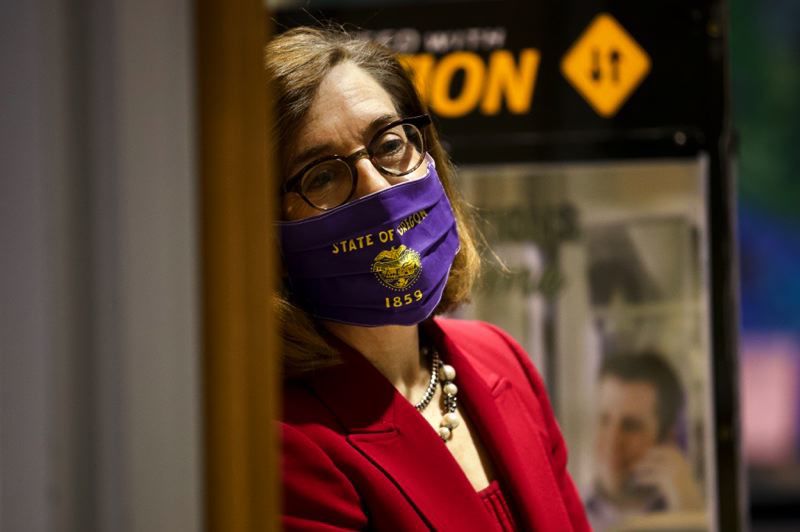Brown defends vaccine priority for educators over the elderly
Published 2:00 pm Friday, January 22, 2021

- PMG PHOTO: JAIME VALDEZ - Gov. Kate Brown, at a May press event, wearing her social distancing mask in public.
Gov. Kate Brown said Friday that she will stick with her controversial plan to vaccinate school staff ahead of elderly residents.
“My priorities have not changed,” Brown said during a press conference.
The current state vaccination priority list calls for an estimated 100,000 K-12 teachers, school staff, child care workers and preschool employees to be eligible for vaccination Jan. 25.
Residents 80 and over will be eligible two weeks later, on Feb. 8. The minimum age will drop five years each week until those 65 and over are eligible on March 1.
Eligibility does not ensure availability. Brown has set a goal of the state’s program administering 12,000 shots per day. With the current vaccines requiring two shots spaced several weeks apart, the goal means 6,000 residents would be fully vaccinated each day in the near future.
Oregon is one of only five states in the nation where the inoculation of those 65 and over has not begun. As of Friday, it is the only state to prioritize educators and staff ahead of older residents.
Oregon has an estimated 767,500 residents who are aged 65 or over out of a total population of about 4.2 million.
Seniors account for 18 percent of Oregon’s population, the 11th highest percentage among the 50 states.
No estimates were available for possible infections, hospitalizations and deaths due to delaying eligibility for older Oregonians, according to Dr. Dean Sidelinger, the state’s top infectious disease expert.
Unofficial estimates can be made with available state data. OHA reported 195 COVID-19 related deaths in the previous week. It was the highest total since the virus arrived in Oregon last winter.
According to OHA statistics, people aged 70 account for 77% of Oregon’s COVID-19 deaths.
Extrapolating those numbers, 390 Oregonians would die from COVID-19 over a two-week period, including 300 aged 70 or older. The estimate was sent to Brown and OHA with a request for comment or provide alternative data.
Oregon Public Broadcasting on Friday used different state data and age ranges to estimate 89 people aged 60 and over would die each week. Over the two week delay in senior eligibility, that would amount to about 178 deaths.
Brown’s press conference came amid a slowdown in COVID-19 in Oregon and much of the nation. But the possible virulence of a virus variant now spreading in the United States has put states on alert for a possible swing back to rising infection rates.
OHA reported 877 new COVID-19 cases and 22 new fatalities on Friday. There have been 136,839 infections and 1,865 deaths in Oregon since the first positive case was reported on Feb. 28, 2020.
The Friday report continues a gradual decline in infections and hospitalizations. It marked the fifth day in a row with fewer than 900 new COVID-19 cases in Oregon.
The current positive infection rate is 5.9% of tests, still above the 5% target set by the OHA to indicate infections are not growing rapidly. Deaths remain high, but are a “lagging indicator” – the last statistic to rise or fall in relation to reported infections.
With each day, Oregon is moving out of the window of time for a feared “Christmas spike” in infections due to residents traveling and gathering for the holidays. Nearly a month has passed since Christmas and three weeks since New Year’s Day and the impact of the holidays has been shorter and shallower than forecast.
Oregon’s experience is in sharp contrast to neighboring California, where records were set in recent weeks for new cases, hospitalizations and deaths.
The Southern California Air Quality Management District lifted restrictions on emissions from cremations to help deal with the backlog of bodies in morgues across the region.
Through January 22, California has reported 3,062,068 COVID-19 infections and 35,768 deaths since the first positive case was reported on Jan. 25 last year.
Oregon also updated its vaccination numbers, saying 253,711 shots have been given since the vaccines began arriving in Oregon late last year.
When the Pfizer and Moderna vaccines became available late last year, The Centers for Disease Control guidelines identified health care workers who are likely to come into contact with COVID-19 patients as the top priority for early vaccination.
The CDC also called for inoculations for nursing home residents and staff. The group accounted for just 5% of infections nationwide, but 36% of the more than 410,000 deaths.
Nursing homes accounted for 53% of all deaths in Oregon, making it one of 12 states where such facilities accounted for more than half of COVID-19 fatalities.
Most states have followed the CDC guidelines in deciding the ongoing priority groups. Older Americans, who are disproportionately more likely to suffer severe and fatal cases, were next on the CDC list. People with medical conditions that put them at risk of severe illness or death were also listed.
Brown and OHA decided to veer from the list, placing educators and school staff in front of the elderly.
With schools mostly closed since March, Brown has consistently said the long-term damage to students’ quality of education, mental health and emotional well-being had been damaged by distance learning. She’s set Feb. 15 as a goal for most schools to reopen if they meet minimum COVID-19 health recommendations.
While noting on Friday that school-age children are not in danger of widespread severe illness or death, Brown said the harm caused by missing class time was a crucial factor in her decision.
Several studies have shown that students are losing ground because of remote learning. Schools also ensure access to meals for some and safeguard against child abuse because someone is seeing the student regularly outside of their home.
Brown cast the prioritization for educators as a brief diversion of vaccine to jump-start education.
“It’s really pretty simple,” Brown said of her priorities. “I am using every single tool I have to get kids back into the classroom this school year.”
But Brown could not quantify the impact of reopening schools next month compared to May or later. School districts and teachers union leaders have questioned whether the vaccination of teachers and staff is enough of a safeguard to reopen schools while overall infection rates remain high.
Courtney Campbell, a medical ethicist at Oregon State University, told Oregon Public Broadcasting that Brown deserves credit for making sure that COVID-19 resources reach underserved communities.
Black and Hispanic residents have a higher risk of infection due to having less access to quality health care, living more often in crowded housing conditions, and are more likely to have jobs that cannot be done remotely.
But Campbell said the decision to bump up school employees on the priority list was questionable at best.
“Health equity does not support prioritizing teachers and K-12 staff,” Campbell said.
Federal guidelines call for the next priority group should be seniors, people with medical issues that put them at high risk of severe illness or death, and essential workers who work face-to-face with the public.
The world has now been in the grip of COVID-19 for more than a year. The first cases were reported in Wuhan, China on Dec. 31, 2019. In the 13 months since then, the pandemic has spread to every continent and is passing two key markers underlining its brutal impact.
The number of infections in the United States passed the 25 million mark on Saturday, according to the Johns Hopkins Coronavirus Resource Center. The worldwide infection count is poised to pass the 100 million mark next week.
Though infection levels are slowing in the United States, the virus is mutating into variants that have caused a sharp rise in cases in Britain, South Africa, and Brazil.
The British variant has been found in Oregon and other states. At first, scientists said it spread 30 to 70 percent faster than the original COVID-19 virus, but did not cause more severe reactions in those who were infected.
But on Friday, British Prime Minister Boris Johnson announced new data which show the variant could be 30 percent more lethal.
Deaths in the U.S. stand at 413,865 on Friday. Worldwide, there have been 2,104,927 deaths.
The virus has had an conspicuously larger impact on the United States than would be expected.
Though the United States has just 4% of the world’s population, it accounts for 25% of all infections and 20% of all deaths during the pandemic.





